
THE ULTIMATE BIRTHSTONE GUIDES
Discover the gemstones of your birth month with the Ultimate Birthstone Guides! From January to December, uncover the knowledge of your modern and traditional birthstones that you probably never knew existed.

The Birthstones of December: Tanzanite, Zircon, Turquoise, and Blue Topaz
Attention to everyone born under the wintry skies of December! We’re thrilled to share some sparkling news with you: Your birth month is adorned with not one, not two, but four stunning birthstones! Embrace the enchanting hues of December with Tanzanite, Zircon, Turquoise, and Blue Topaz, each celebrated for their captivating colors and rich history. Dive into a journey of discovery as we explore the symbolism, fascinating origins, and unique characteristics of these mesmerizing gemstones. Let’s unravel the stories behind Tanzanite, Zircon, Turquoise, and Blue Topaz together!
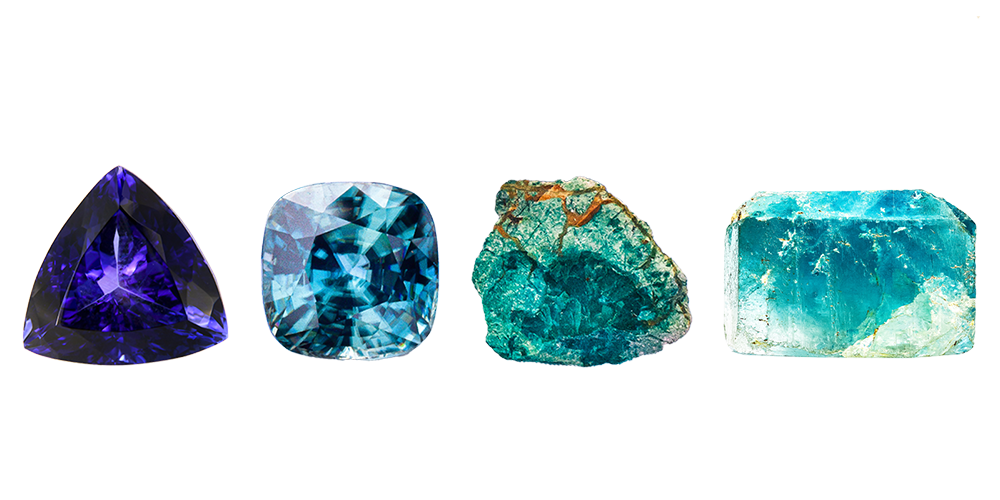
Tanzanite, Zircon, Turquoise, and Blue Topaz Loose Gemstones
Tanzanite, Zircon, Turquoise, and Blue Topaz, Chosen Specifically for December
Why does December have four birthstones?
December dazzles with not just one, but four unique birthstones: Tanzanite, Zircon, Turquoise, and Blue Topaz, each with a rich history that has cemented its association with this festive month. While most months are graced with one or two birthstones, December is among the exclusive few that boast multiple gemstones, adding to its special allure.
The intriguing world of birthstones is divided into two categories: modern and traditional. Modern birthstones, which became standardized in the 1950s by the Jewelers of America, are the most commonly recognized today. In contrast, traditional birthstones hark back to earlier associations, popular in the early 20th century and even earlier. Over time, some traditional gems have become rarities, leading to the inclusion of newer, more accessible modern counterparts for certain months.
Now, let’s delve into December’s gemstones. Among its four stones, can you identify which are considered modern and which hold the traditional title? December’s selection includes three modern birthstones and one traditional gem. Take a guess and see if you can unravel this sparkling mystery!

Exploring Timeless Tanzanites
Origins & Features of Tanzanites
One of the modern birthstones for December is Tanzanite. The name ‘tanzanite’ was initially coined as a more market-friendly alternative to its scientific name, ‘blue-violet zoisite’.
This rebranding was introduced to the market in 1968 by Tiffany & Co.’s marketing department, drawing its name from the gemstone’s geographic origin, Tanzania.

Tanzanite is actually a variety of the mineral zoisite and has risen in popularity due to its exquisite blue-purple or blue-violet color. This rare blue hue of zoisite was discovered in 1967. Since then, techniques to enhance its beautiful color through heat treatment have been developed. Zoisite contains traces of vanadium, which, when subjected to high heat, transforms into the cherished blue-purple color prevalent in today’s market.
Natural purple and blue Tanzanites are the most rare and valuable.
Additionally, Tanzanite exhibits the phenomenon of pleochroism, which allows the stone to display different colors when viewed from various angles. However, to eliminate the natural brown hues of zoisite during its transformation into Tanzanite, precise and skillful cutting is essential to reveal its stunning blue and purple hues.
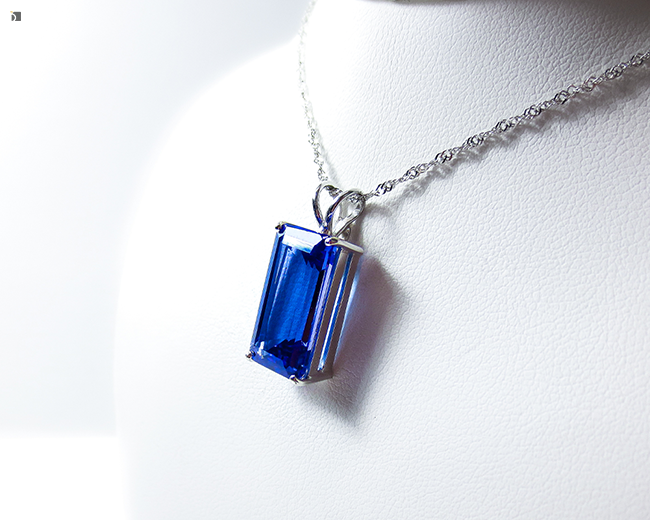
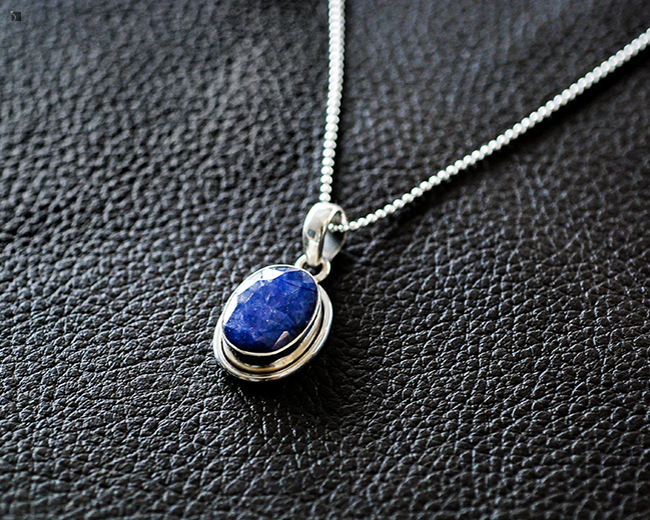
The Rich History and Deep Symbolism of Tanzanite
Cultural Significance and Fun Facts: Tanzanite in Lore and Legend
Tanzanite, a rare and captivating gemstone, can only be naturally found and sourced near Mount Kilimanjaro in Tanzania. Its scarcity means its value is heavily influenced by the production levels of mines in this region. Interestingly, production has been on the decline over time.
The first discovery of tanzanite stemmed from the search for sapphire deposits in Tanzania. In 1967, a Masai tribesman stumbled upon these unique blue gemstones and informed a local fortune hunter, Manuel d’Souza, who was instrumental in claiming some of these mines. Initially mistaking them for sapphire, d’Souza unknowingly played a pivotal role in uncovering one of the world’s newest gemstones.
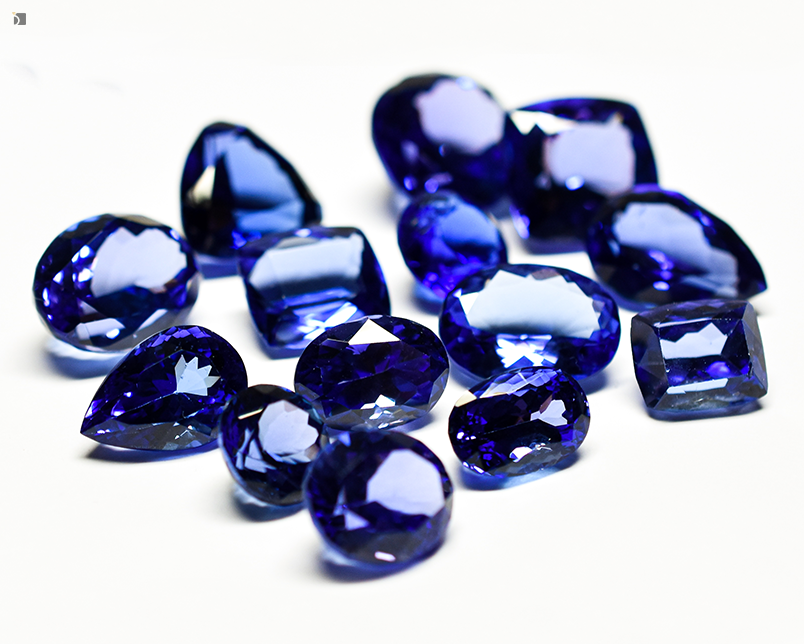
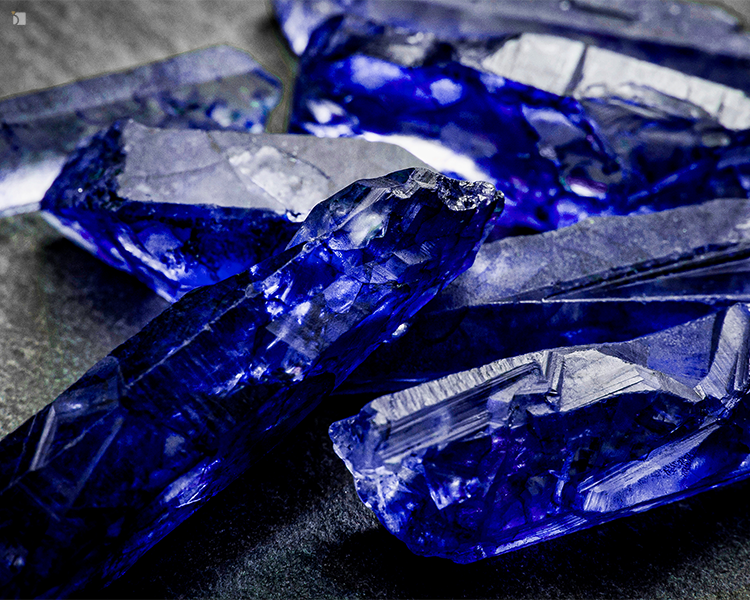
Tanzanite is revered across various cultures for its believed properties and powers:
- It’s thought to possess the ability to transform negative energy into positive energy.
- With the growing interest in manifestation practices, this gemstone is believed to stimulate one’s determination and willpower.
- It’s also associated with finding internal balance in power and self-actualization.
- Tanzanite is often linked to the throat, third eye, and crown chakras, purportedly enhancing communication and psychic abilities.
Buying the Right Tanzanite For You
When selecting the perfect tanzanite, it’s essential to consider the same key factors that apply to other precious gemstones: Color, Clarity, Cut, and Carat. Tanzanite, however, has unique characteristics that set it apart. Its value is primarily influenced by its exceptional color, ranging from vibrant blue to rich violet hues, often shifting depending on the angle and lighting. In addition to the Four C’s, the intensity of tanzanite’s color saturation is particularly significant, with the deepest, most vivid blue-violet stones being the most prized. While tanzanite is available in a spectrum of shades, the finest specimens exhibit a mesmerizing, velvety blue with hints of purple, making these stunning gemstones highly coveted.
Celebrating both the 24th wedding anniversary and December birthdays, tanzanite is a symbol of balance and natural beauty, making it an exquisite gift for these special milestones.

Essential Tips for Maintaining and Caring for Your Tanzanite
Tanzanites rank between 6 and 7 on the Mohs scale of hardness. Given that this scale goes up to 10, it’s clear that tanzanites require extra care due to their relatively moderate hardness.
To better understand this scale, consider that quartz, commonly found in dust particles floating in the air and settling on surfaces in your home, has a hardness of 7 – 7.5. These tiny quartz particles are abrasive enough to dull the polish on your table or the finish on your car. On the other end of the scale, diamonds are the hardest gemstones with a hardness of 10, while the softest, like talc, can be scratched even by a fingernail. Each mineral can only be scratched by substances of a higher hardness level, which means tanzanite jewelry should be worn cautiously.
Despite their hardness, your precious gemstones still deserve careful maintenance to retain their sparkle and pristine appearance. Therefore, it is not advisable to wear tanzanite pieces for everyday use.
For cleaning tanzanite, use mild soap and warm water with a soft cloth. It’s important to avoid bleach, harsh chemicals, and abrasive cleaners when cleaning your jewelry at home. This includes avoiding lotions and sanitizers. Tanzanite should also be protected from high heat and sudden temperature changes, as these can cause internal cracks in the gemstone. Moreover, it is recommended to never clean tanzanite with ultrasonic or steam cleaners and to avoid prolonged exposure to heat and sunlight.
For more detailed care, including professional cleaning and polishing, we invite you to explore our Gemstone Services.

Exploring Zealous Zircons
Origins & Features of Zircons
The other modern birthstone for December is Zircon.
The origin of the name ‘zircon’ is still a subject of debate. Some believe it comes from the Persian word ‘zargun,’ meaning ‘gold-colored.’ Others think it derives from the Arabic word ‘zarkun,’ meaning ‘cinnabar’ or ‘vermilion.’
It’s important to note that zircon is often confused with cubic zirconia, although they are completely different gemstones.
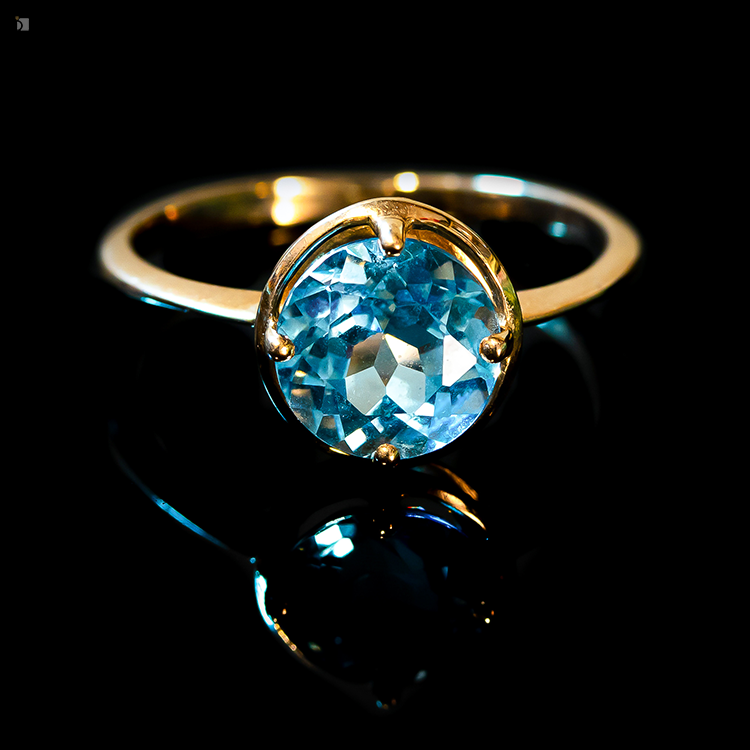
Zircons are available in a variety of colors, including red, orange, yellow, green, blue, brown, and even colorless. The colorless form of zircon, known for its multicolored flashes of light — often referred to as ‘fire’ — can sometimes be mistaken for a diamond. However, zircon is more brittle. This colorless variety is also known as ‘Matura Diamond.’
The most valuable color of Zircon is blue.
The most commonly found zircon is brown-red in hue and enjoys considerable popularity. Blue zircon is the most valuable due to its striking appearance, while green zircon is exceptionally rare and thus highly prized. Many high-quality zircons, especially those in blue, gold, or colorless varieties, are heat-treated to enhance their color.
Like many gemstones, the varied colors of zircon are attributed to impurities and the presence of different minerals within the gemstone. Some impurities, such as uranium, can render the stone slightly radioactive. This radioactivity is stabilized through heat treatment.
The Rich History and Deep Symbolism of Zircon
Cultural Significance and Fun Facts: Zircon in Lore and Legend
The history of the zircon gemstone stretches back 4.4 billion years, making it one of Earth’s oldest minerals. One of the most abundant sources of zircon is found in the diverse landscapes of Sri Lanka, featuring mountains, jungles, and streams. Australia also plays a significant role as a zircon supplier, contributing 37% of the global supply. Other notable sources include Thailand, Tanzania, Cambodia, Canada, and the United States.

Throughout different times and cultures, zircon gemstones have been attributed with various symbolic meanings and powers:
- In the Middle Ages, zircons were thought to induce deep sleep and ward off evil spirits.
- According to Hindu beliefs, wearing zircon with hessonite garnet can bring wealth, wisdom, and good health.
- Zircon is said to enhance meditation and psychic intuition.
- Similar to its modern gemstone counterparts, zircon is believed to transform negative energy into positive energy.
- In various cultures, zircon is thought to aid in organization.
Buying the Right Zircon For You
When selecting the perfect zircon, it’s essential to consider the same key factors that apply to other precious gemstones: Color, Clarity, Cut, and Carat. Zircon, however, has unique characteristics that set it apart. Its value is often influenced by its remarkable brilliance and the intensity of its color, which can range from clear, colorless stones to shades of blue, yellow, green, and brown. In addition to the Four C’s, the specific color tone of zircon is particularly significant, with vivid blue zircons being especially prized. While zircon is available in a wide variety of hues, the finest specimens exhibit exceptional clarity and fire, making these dazzling gemstones highly sought after by collectors and jewelry enthusiasts alike.
With blue zircon being associated with the 4th wedding anniversary and yellow zircon with the 11th, this stone symbolizing positivity and organization makes an excellent gift not only for these specific anniversaries but also for those celebrating a December birthday!
Essential Tips for Maintaining and Caring for Your Zircon
Zircons have a hardness of 6 to 7.5 on the Mohs scale. As mentioned earlier, minerals can only be scratched by substances with a higher level of hardness. Therefore, it is advisable to avoid wearing zircon jewelry during activities like cleaning, gardening, and sports to prevent damage.
For home care, we recommend cleaning zircon with warm water, mild soap, and a soft brush, such as a toothbrush with soft bristles, or using a soft cloth. Just like with tanzanite, it’s best to avoid using steam cleaners, ultrasonic cleaners, and to protect the gemstone from prolonged exposure to sunlight and high heat.
To learn more about our professional cleaning and polishing services, please visit our Clean & Polish Services page for additional information.

Exploring Terrific Turquoise
Origins & Features of Turquoise
The traditional birthstone for the month of December is Turquoise. The name ‘turquoise’ originates from the French phrase ‘pierre turques,’ meaning ‘Turkish stone.’ This refers to the stone’s introduction to Europe via Turkey.
In ancient Egypt, it was known as ‘mefkat,’ meaning ‘delight’ or ‘joy,’ and was also referred to as the ‘Turkish blue’ stone.
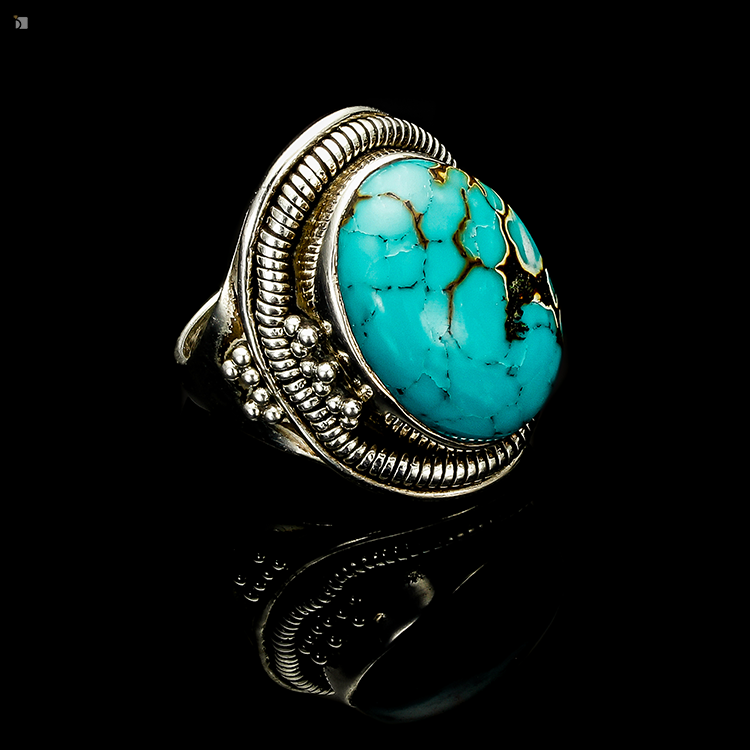
Turquoise is renowned for its unique blue and green hues. The blue color in this gemstone comes from traces of copper, while the green is derived from traces of aluminum, iron, and chrome. Turquoise forms when rainwater causes copper to dissolve in the soil, leading to the creation of deposits that combine aluminum, phosphorus, and these other minerals.
Turquoise is the only gemstone that has a color named after it.
The well-known cracks in turquoise gemstones are referred to as its ‘matrix,’ which often resemble webs and veins. However, the more matrices and cracks a piece has, the lower its value. The color of turquoise can also be altered through dyeing or chemical enhancement with epoxy or acrylic resin; this process not only enhances its color but also solidifies its relatively low hardness.
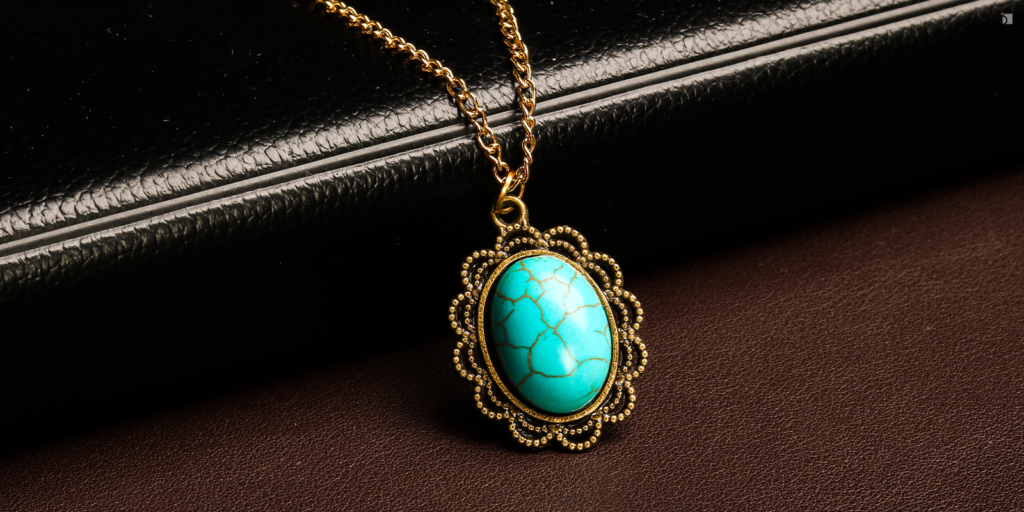
The Rich History and Deep Symbolism of Turquoise
Cultural Significance and Fun Facts: Turquoise in Lore and Legend
The first turquoise deposits were discovered in an ancient Egyptian mine on the Sinai Peninsula. The Nishapur district in Iran has been a productive source of turquoise for more than 1,000 years. Significant deposits are also found in the Hubei Province in Central China and in New Mexico, United States.
Turquoise has been a valued and cherished gemstone for millennia, with various properties and beliefs associated with it across different cultures:
- In Nepalese and Tibetan cultures, turquoise was believed to have descended from the heavens, earning it the moniker ‘sky stone.’ It was commonly gifted to children for protection and safety.
- Native American cultures held turquoise in high regard, considering it sacred and believing it aided in spiritual growth through its metaphysical properties.
- The Apache believed that turquoise could be found at the end of a rainbow and that attaching it to a bow could enhance the accuracy of one’s aim.
- In European tradition, turquoise is a traditional gift for ‘forget-me-not’ rings.
- Across many cultures, this gemstone has been believed to bring good fortune and health. It is considered a national treasure in Tibet, revered not only for its protective properties against evil but also for its believed ability to ensure well-being.
- Generally, turquoise is thought to promote peace for its wearer.
Buying the Right Turquoise For You
When selecting the perfect turquoise, it’s essential to consider the same key factors that apply to other gemstones: Color, Clarity, Cut, and Carat. Turquoise, however, has unique characteristics that set it apart. Its value is often influenced by the vibrancy and consistency of its blue to green hues. In addition to the Four C’s, the specific color tone of turquoise is particularly significant, with shades ranging from sky blue to a deep greenish blue. While turquoise can feature natural veining or matrix patterns, the most prized pieces are those with a pure, robin’s egg blue hue and minimal matrix, making these captivating gemstones especially sought after for their timeless beauty and cultural significance.
With turquoise being associated with the 11th wedding anniversary, this stone symbolizing good fortune, peace, and protection makes an excellent gift for those celebrating such milestones as well as for a December birthday!
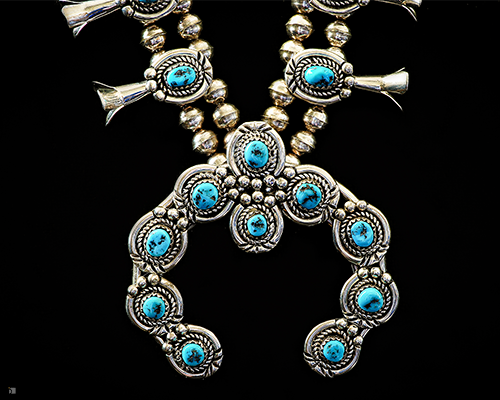

Essential Tips for Maintaining and Caring for Your Turquoise
Turquoise gemstones rank between 5 and 6 on the Mohs scale of hardness, which is significantly lower compared to the hardness of other December birthstones. As mentioned previously, a mineral can only be scratched by substances with a higher level of hardness.
The color of turquoise gemstones can change when exposed to sunlight, as high heat can cause both discoloration and breakage in the stone. It is not recommended to wear your precious turquoise pieces when handling acids and chemicals. These can be commonly found in makeup, cleaning products, and even in the natural oils of your skin.
For cleaning turquoise jewelry at home, use mild soap or detergent in warm water, similar to the recommended method for other December birthstones. Importantly, turquoise should never be cleaned using steam or ultrasonic cleaners.
To learn more about our professional cleaning and polishing services, please visit our Clean & Polish Services page for additional information.

Exploring Brilliant Blue Topaz
Origins & Features of Blue Topaz
Blue Topaz, one of the four official birthstones for December, is a gemstone celebrated for its vibrant blue hues and remarkable brilliance.
Its name is derived from the Sanskrit word “tapas,” meaning fire, and the Greek word “topazos,” referring to a location where gemstones were historically found.

The majority of Blue Topaz available today is produced by treating colorless or lightly tinted varieties with a combination of heat and irradiation to achieve their stunning hues. This treatment process has made Blue Topaz one of the most accessible and popular colored gemstones in the market.
Natural blue topaz gemstones are extremely rare in nature.
Blue Topaz comes in three primary shades: Sky Blue, Swiss Blue, and London Blue, with London Blue being the deepest and most valued for its rich, steely blue tone. Its high refractive index contributes to its brilliance, making it a favorite for both casual and formal jewelry designs.
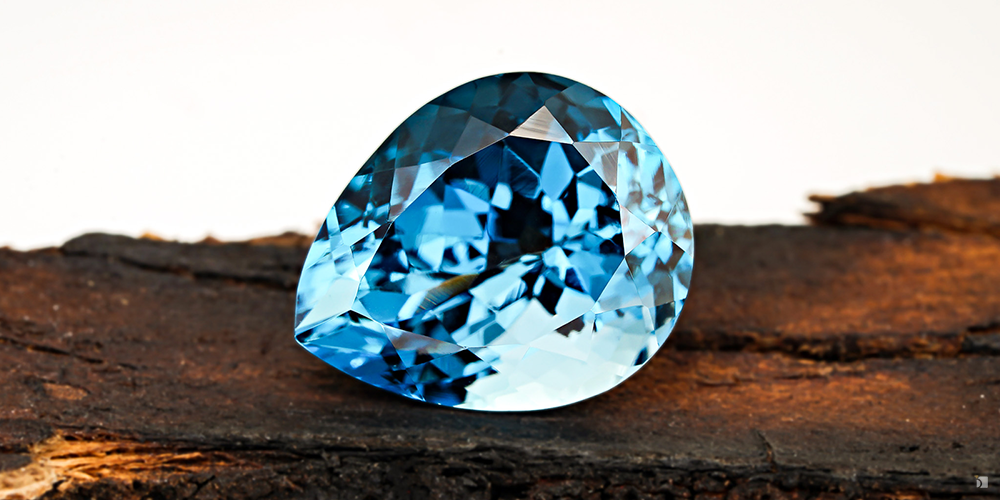
The Rich History and Deep Symbolism of Blue Topaz
Cultural Significance and Fun Facts: Blue Topaz in Lore and Legend
Blue Topaz has a rich history of cultural significance and lore that adds to its charm and mystique:
- Ancient Egyptians believed topaz was colored by the golden glow of the sun god Ra, symbolizing protection and power.
- In Renaissance Europe, topaz was thought to dispel enchantments and improve mental clarity, earning it a reputation as a gemstone of wisdom.
- In Hindu mythology, topaz was associated with the planet Jupiter and thought to bring wealth, wisdom, and long life.
- Blue Topaz is also recognized as the gemstone of the 4th wedding anniversary, signifying enduring love and commitment.
- Due to its vibrant hues and affordability, Blue Topaz is one of the most popular gemstones among consumers today, with its tranquil blue shades symbolizing calmness, clarity, and harmony.
With its captivating color and cultural significance, Blue Topaz remains a timeless gemstone beloved worldwide.
Buying the Right Blue Topaz For You
When selecting the perfect Blue Topaz, it’s essential to consider the same key factors that apply to other gemstones: Color, Clarity, Cut, and Carat. Blue Topaz, however, has unique characteristics that set it apart. Its value is heavily influenced by the saturation and uniformity of its blue hues. Sky Blue Topaz is pale and delicate, Swiss Blue Topaz offers a bright and vivid color, and London Blue Topaz captivates with its deep, sophisticated tone.
Natural blue topaz is a rare occurrence, making untreated stones exceptionally valuable. However, the widespread practice of treating colorless topaz has made vibrant Blue Topaz more accessible, offering a wide range of options to suit various tastes and budgets. This prevalence of treated Blue Topaz has contributed to its immense popularity, particularly among consumers seeking a dazzling yet affordable gemstone.
In addition to the Four C’s, the cut of Blue Topaz is crucial, as its faceting enhances its brilliance and fire. Whether in a classic oval, emerald cut, or a modern design, Blue Topaz’s versatility ensures it shines in every setting.
Blue Topaz’s vibrant colors and enduring beauty make it a meaningful gift for December birthdays or those celebrating a 4th wedding anniversary, symbolizing loyalty, love, and harmony.
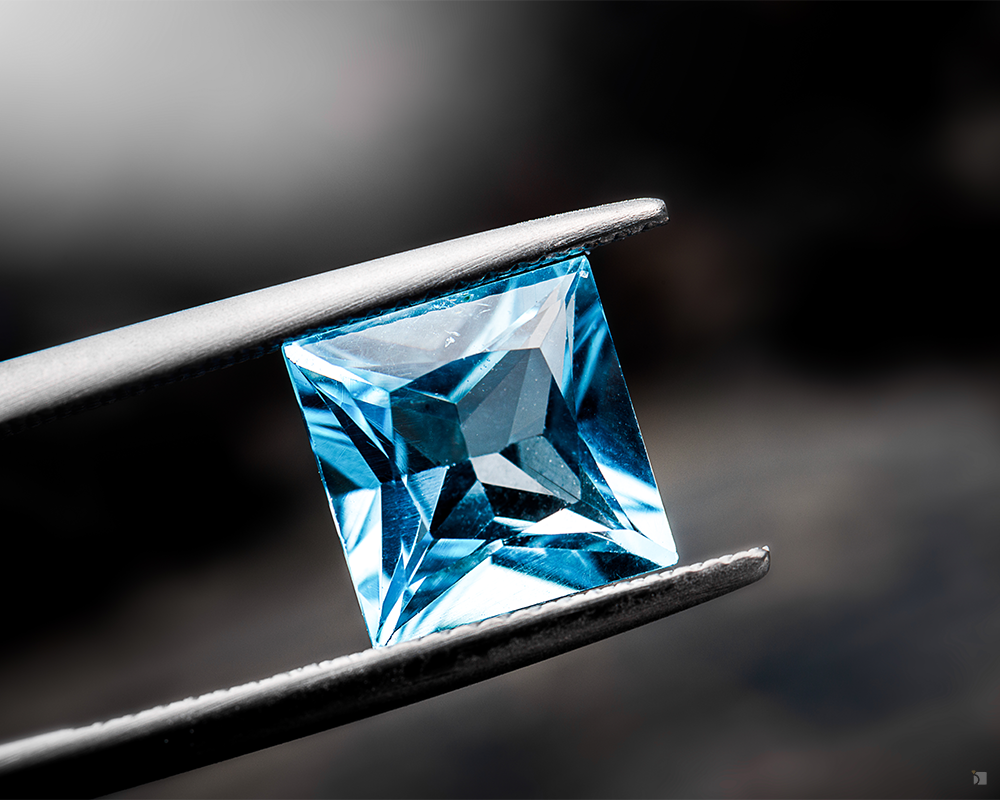
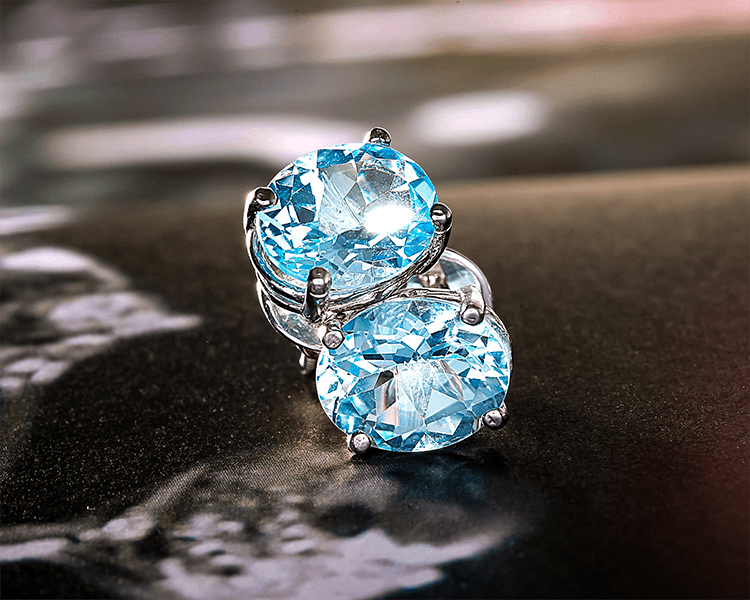
Essential Tips for Maintaining and Caring for Your Blue Topaz
Blue Topaz gemstones rank 8 on the Mohs scale of hardness, making them relatively durable, but they can still be susceptible to scratches or damage from sharp impacts. Protecting Blue Topaz from prolonged exposure to direct sunlight is important, as it may cause fading or discoloration over time.
Avoid wearing Blue Topaz jewelry when handling harsh chemicals or cleaning products, as these can compromise the stone’s surface. Even natural oils from your skin can build up over time, dulling its brilliance.
For at-home cleaning, use a mild soap or detergent in warm water and gently scrub the gemstone with a soft brush. Avoid steam or ultrasonic cleaners, as they can damage the stone. Regular professional cleanings and inspections can help maintain the brilliance and structural integrity of your Blue Topaz.
To learn more about our professional cleaning and polishing services, please visit our Clean & Polish Services page for additional information.

Replacing Your Missing Tanzanite, Zircon, Turquoise, or Blue Topaz
Thinking about restoring a sentimental birthstone piece for a loved one? You’ve come to the right place to revive those precious memories.
Gemstones add life and brilliance to any piece of jewelry, yet they are also the most prone to damage. Whether it’s a loose, lost, or scratched Tanzanite, Zircon, Turquoise, or Blue Topaz, we take the restoration of your treasured items seriously. No matter the gem or the type of damage, we are committed to making your jewelry sparkle as brightly as the day you received it.
Our team of specialists is expertly equipped to source every type of gem needed for your treasured item. We understand that your gemstones are unique and require specific care and attention. Our Professional Stone Sourcing team ensures that all of your gems, even those that may sometimes go unnoticed, are replaced with stones that perfectly match the quality and caliber of your piece.
Visit our Gemstone Replacement Services page to learn more about how we can restore the brilliance of your Tanzanite, Zircon, Turquoise, or Blue Topaz jewelry.
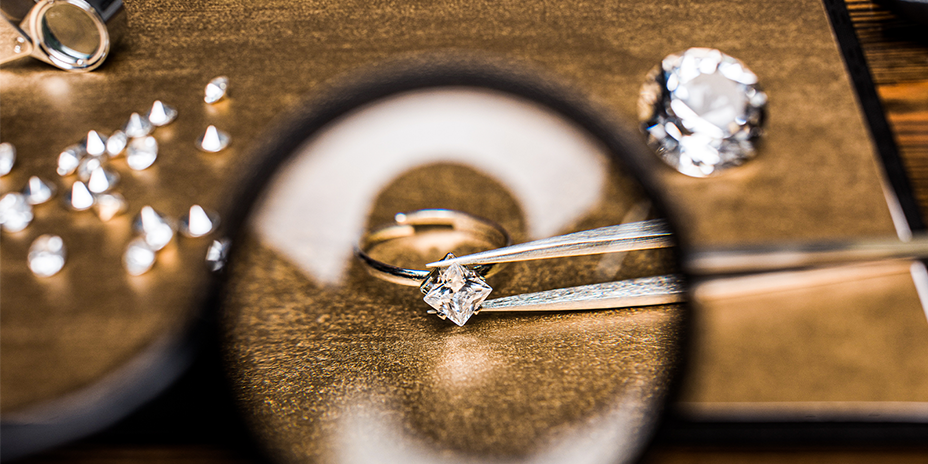
Originally Published October 7, 2019, Updated and Expanded November 15, 2024

Resources:
- December Birthstone Information: https://www.americangemsociety.org/
- December Birthstone Information: https://www.gia.edu/
- October Birthstone Information: https://www.gemsociety.org/
- Blog outline and revising assisted by AI resources such as Chat-GPT.
Have Questions?
The Ultimate Birthstone Guide
“If you were born in December, your month’s birthstones are Tanzanite, Zircon, Turquoise, and Blue Topaz.
If you didn’t already know, there are some months that have multiple birthstones, whereas some only have one. Traditional birthstones are gemstones that were most commonly associated with its respective month in the early 20th century and even beyond, with Ancient Greek and Roman philosophers associating these gemstones with the star signs. Those that are more commonly known in this day and age are the modern birthstones, which were officially named by the Jewelers of America in the 1950’s.
If you would like to learn more about birthstones in general, visit our Ultimate Birthstone Guide!“
Clean & Polish Services
“A basic clean, polish, and inspection is part of the routine care and maintenance needed to keep your jewelry looking like new. The inspection process includes looking for loose stones, bent prongs, and any damage to the metal or stones that need to be repaired.”
Stone Setting Repair
“A stone setting repair can be a simple re-tipping of a worn prong (which is considered routine care and maintenance) or the complete rebuilding/replacing of a damaged prong. In the case of severe damage, the entire head of the ring may need to be replaced.
Regardless of whether or not the prongs are compromised due to normal wear and tear or a result of accidental damage, we can provide the routine care and maintenance in order to ensure you do not lose a stone in your setting.”
Gemstone Replacement Services
“The process of a Gemstone Replacement is simple enough, yet requires trained eyes to be able to make a flawless switch. We aim to leave no trace of our work, which means not only will your setting be perfected, but the gemstone we choose will complete your jewelry piece effortlessly.”
Explore the Magic of Our Gemstone Services!
We are proud members of the

Our team includes gemologists certified by

